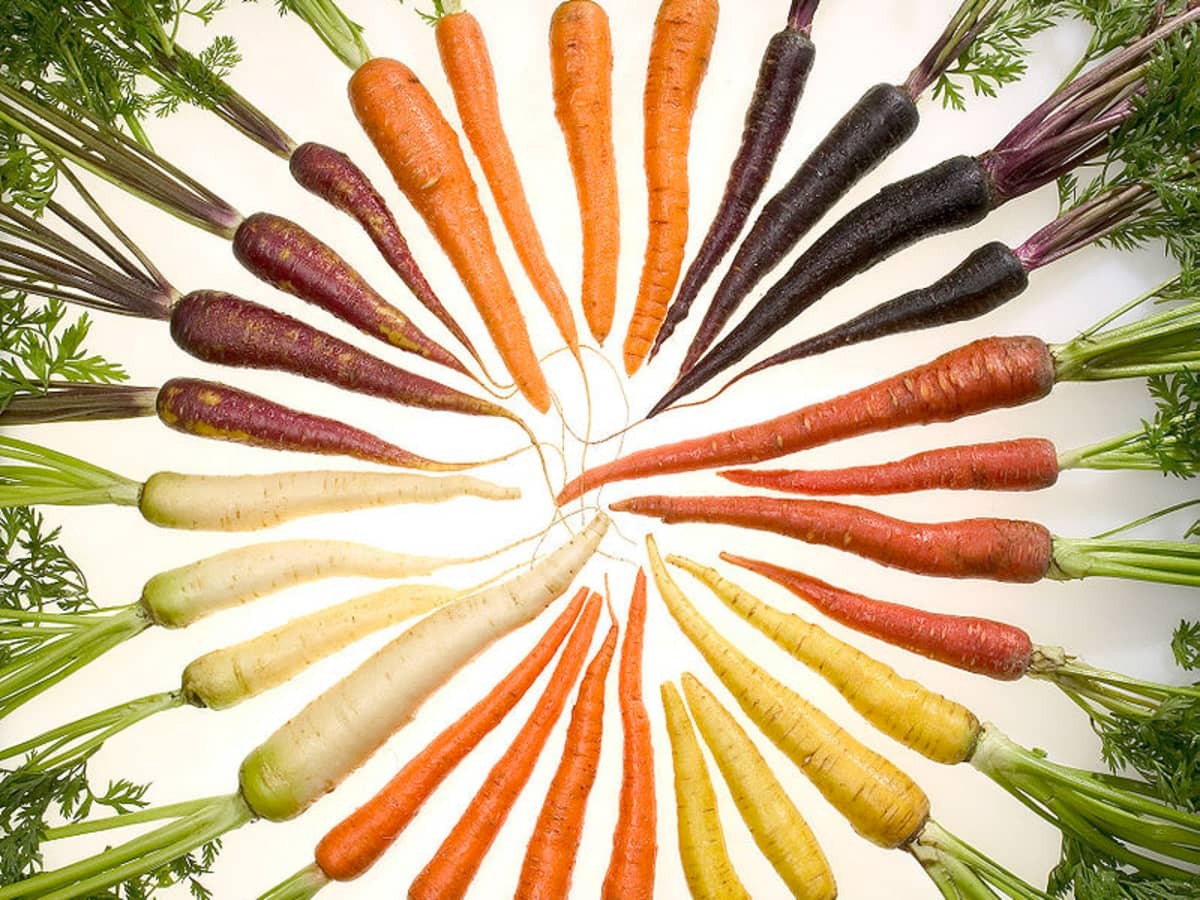Many people think carrots are always orange. In reality, most of the carrots we see today come from the wild, white carrot. These “carrots” were small and had tough roots with many branches and would have tasted bitter to us.
We can likely trace carrots back as far as 8-900 AD, where they originated in Central Asia and the Middle East. The purple and white carrot was what people primarily ate until the 15th century, where we saw the introduction of the orange variety.
Carrots we eat today are the result of centuries of breeding for various colors, sweeter flavor and larger roots.This breeding accidentally led to the creation of a new and improved variety of carrots that have excellent nutritional properties which give carrots their amazing vitamin A and antioxidant properties, as well as different colors due to their composition.
What do the different colors represent?
The domestication of carrots has resulted in a wide range of colors, including purple, orange, yellow, red and white. Each color provides different nutrients which all have various health benefits. It also makes cooking fun because you get to mix up the ingredients!
The amount and kind of pigmentation, including carotenoids and anthocyanins, are what give carrots their color. Furthermore, it serves as a gauge for the carrot’s nutrient level. The fact that a single vegetable can be prepared in so many various ways and still offer our bodies a wide range of nutrients is remarkable. Even the hues of carrots serve to illustrate how important variety in nutrition is!
As the color gets darker and darker, so do the levels of antioxidants and vitamin A. That doesn’t mean the lighter carrot is any less nutritious, they just have different nutrients.
Orange Carrots
Orange carrots contain large amounts of beta carotene, a pigment that gives many fruits and vegetables their yellow/orange color. These carrots taste earthy and sweet and are healthy to consume both fresh and cooked. Orange carrots can be eaten as a snack with a dipping sauce, in salads and slaw, or as a substantial entrée with other ingredients such as spicy potatoes, cabbage, etc.
Orange carrots are the highest in beta-carotene, and contain lesser amounts of alpha-carotene. Both these antioxidants are converted by the liver into vitamin A in our bodies—and orange carrots also contain lutein and zeaxanthin.
Vitamin A is an essential component in eye health and lutein helps make up the macular pigment of human retinas. By consuming it, you can increase the density of this substance—which has been shown to decrease your risk for macular degeneration and other age-related diseases.
Yellow Carrots
Yellow carrots lack the customary earthiness found in the other colors of carrots and have a mild flavor. In addition, compared to orange, red, and purple carrots, these varieties are noticeably sweeter. They taste best when roasted, but you may also glaze them by frying them in a pan with some butter and sugar. They will lend a wonderful pale color and a pleasantly unexpected sweetness to a stew or soup.
The major pigments in yellow carrots are xanthophylls, which give their golden hue, and lutein—a similar compound to beta-carotene.
The major pigments of yellow carrots are xanthophylls (which gives the golden color), lutein, which is similar to beta-carotene and helps with eye development. Anthocyanins have also been attributed for their role in producing carrot’s distinctive hue
Red carrots
Red carrots contain the highest amount of lycopene, which gives them their vivid color and is believed to combat macular degeneration and other eye diseases as well as helping prevent heart disease and certain types of cancers. Lycopene may also have a beneficial effect on skin tone.
When it comes to flavor, red and orange carrots are very similar. Use red carrots in inventive ways by incorporating the colorful vegetable into dishes like creamy carrot soup or gingered carrot soup. By baking, braising, or glazing them, you can take advantage of both their stunning color and beneficial lycopene.
White Carrots
Although white carrots do not have pigmentation, they still retain certain health benefits—such as dietary fiber and a healthy source of sugar that is beneficial for digestion.
They tend to have a rich, powerful flavor and crisp, juicy texture, but they also have less carotene than any of the coloured types.
Purple Carrots
Purple carrots are the strangest in appearance, but they were one of the earliest cultivated varieties. They contain far more anthocyanins than other carrot colors—an entirely different class of pigment which helps protect key cell components from free-radical damage.
The flavor of purple carrots is very sweet, and occasionally it also has a peppery undertone. This occurs more frequently in purple carrots since they maintain their color both inside and out. However, the peppery flavor isn’t always there and is frequently muted. In either case, purple carrots taste fantastic eaten raw, as crudités, in salads, or in sour pickled carrots.
Purple carrots help protect against cellular damage, aging and other health problems. They repair damaged proteins in blood vessel walls and prevent connective tissue from breaking down. Purple carrots also slow blood clotting while being good anti-inflammatory agents—all of which can be used to treat a variety of ailments including heart disease or embolism.
Purple carrots contain the same nutrients as orange ones: beta-carotene, alpha-carotene and small amounts of lutein and zeaxanthin.
Colored carrots are really popular.
Farmers all across the country have started using a variety of colors on stands during the past ten years, though they are not yet common in supermarkets. More lately, their popularity has increased significantly.
Author Bio:
Hi, I’m Rana and I blog at ranasrecipe.com. My passion for food began very early in my life. And after managing a cafe, a granola business and helping other food businesses scale up, I found my true calling in creating wonderful recipes so that everyone can enjoy cooking as much as I do! Don’t forget to follow me on my social channels- instagram and pinterest.



